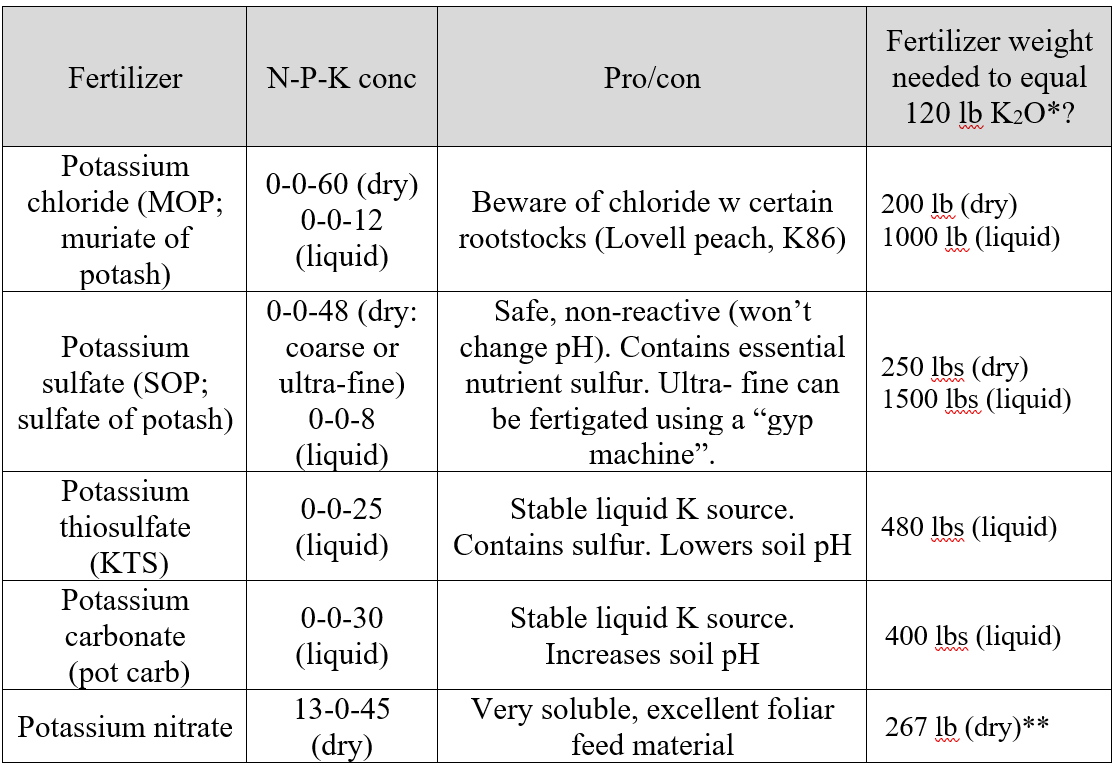Franz Niederholzer, UCCE Farm Advisor; Colusa and Sutter/Yuba Counties
With the crop load largely set, the focus is now on growing the largest, best quality fruit possible. That means maintaining adequate water and nutrition up to harvest. The fruit won’t grow any faster with extra water and nutrition, but without good irrigation and proper nutrition, the fruit will be smaller and grower income less than if irrigation and especially potassium (K) is maintained at adequate levels.
Potassium (K) is the most important mineral nutrient in prune production. Potassium deficiency can mean less crop and/or smaller fruit at harvest plus more vulnerability to disease, especially Cytospora. Summer (now) is the most critical time for K nutrition. If the roots can’t get enough K from the soil to support fruit growth, the needed K is taken from leaves resulting in potassium deficiency symptoms (yellowing leaves), reduced photosynthesis and smaller fruit. In cases of extreme K deficiency, trees can die after harvest due to leaf loss, root starvation and salt poisoning. Severe potassium deficiency also can create a cascade of trouble [yellow leaves –> early leaf drop –> sunburned wood –> Cytospora infection.] 
With stakes like these (grower income, orchard health), maintaining good K fertility/nutrition should be one of the top concerns for growers looking to maximize returns. The following is a review of the 4R’s of K management in prunes.
Right rate: The minimum annual K nutrient budget should be equal to the K used by the crop that year. A dry ton of prunes contains roughly 30 lbs of K2O. Clay soils hold K on the surface of clay minerals and organic matter, so fertilizing crops on loam to clay soils often requires high rates of K fertilization to satisfy soil and crop.
What about foliar K? A “foliar only” program of 4 x 25 lbs potassium nitrate per acre per year (4 sprays/year) can be as effective as 600 lbs fall soil applied MOP (potassium chloride) in maintaining leaf K levels in a high producing, flood irrigated prune orchard (early 1990’s research). While foliar K keeps good nutrition in the trees, it’s a “band-aid program”, not a long-term, sustainable program for K nutrition. Why is that? 100 lbs potassium nitrate = 45 lbs K2O while a 3 dry ton prune crop uses 90 lbs K2O /acre; that means half of the crop’s K came out of the “soil K bank”. That’s a net loss to the soil that will have to be “paid off” with extra fertilizer in the future to avoid reduced soil K availability over time.
Right timing: Prune fruit use K at a steady pace through the growing season, but K is harder for the roots to “find” in the summer when root growth slows as fruit growth gets most of the tree’s energy. Fall application of dry potassium banded or broadcast under micro-sprinklers costs less for material (dry fertilizer) per acre compared to fertigated K (at the same rate of K2O per acre) during the growing season. Fall K application is a “blind” investment as the crop set in March determines how much K is really needed that season. On the other hand, soils hold unused K for another year. Some growers hedge their best by splitting the annual K fertilizer rate and applying half as less expensive dry material (SOP or MOP) and the second half in the growing season via fertigation (using ultra-fine SOP thru a gyp machine, liquid KTS, potassium carbonate, etc.).
If fall soil K application wasn’t done or the rate reduced, make sure enough K is available to the trees by fertigation (delivery of K to the roots with irrigation water) and/or foliar fertilization with potassium nitrate or equal amount of K2O in another formulation.
Right location: Potassium is relatively immobile in soils, so the fertilizer K should be delivered as close to active roots as possible. If using drip irrigation, band dry K near the drip hose where irrigation water reaches or fertigate through the drippers. If using microsprinklers, put the dry material where the irrigation water will reach or inject K through the sprinklers. Injecting K through full coverage sprinklers is very inefficient – less of the fertilizer will end up in the trees compared to locally applied fertilizer.
Right material: All K fertilizers are water soluble and deliver good tree nutrition when applied near roots. Some forms are more convenient, some provide extra amendment or nutrient value. Prices vary 100% based on form and chemistry.
************************************************************************************

Five major potassium fertilizer materials (in different forms), concentration in the commercial product(s), advantages/disadvantages and how much on a weigh basis (for dry or liquid product) equals the K content of 4 dry ton/acre (30 lbs K2O/ton of dry fruit. *Amount of K used by 4 dry ton/acre crop; ** Use 20-25 lb fertilizer/acre/spray.
Overall K strategy:
Keep leaf K in the range of 1.3-2.0% in July. Leaf K less than 1% is deficient and will reduce yield and fruit size.
Don’t sleep on K for your orchard(s). It could cost you!


Leave a Reply